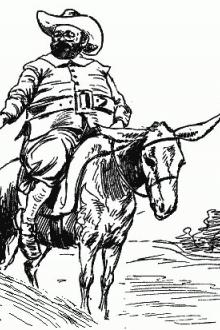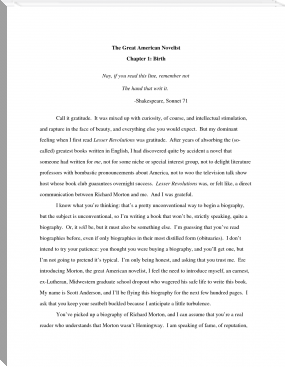The Rifle Rangers, Mayne Reid [intellectual books to read txt] 📗

- Author: Mayne Reid
Book online «The Rifle Rangers, Mayne Reid [intellectual books to read txt] 📗». Author Mayne Reid
Quadrupeds and quadrumana appear. The red monkey (Mono Colorado) runs at the traveller’s approach, and, flinging himself from limb to limb, hides among the vines and Tillandsia on the high tree-tops; and the tiny ouistiti, with its pretty, child-like countenance, peers innocently through the leaves; while the ferocious zambo fills the woods with its hideous, half-human voice.
The jaguar is not far distant, “laired” in the secret depths of the impenetrable jungle. His activity is nocturnal, and his beautiful spotted body may not be seen except by the silver light of the moon. Roused by accident, or pressed by the dogs of the hunter, he may cross my path. So, too, may the ocelot and the lynx; or, as I ride silently on, I may chance to view the long, tawny form of the Mexican lion, crouched upon a horizontal limb, and watching for the timid stag that must pass beneath. I turn prudently aside, and leave him to his hungry vigil.
Night brings a change. The beautiful birds—the parrots, the toucans, and the trogons—all go to rest at an early hour; and other winged creatures take possession of the air. Some need not fear the darkness, for their very life is light. Such are the “cocuyos”, whose brilliant lamps of green and gold and flame, gleam through the aisles of the forest, until the air seems on fire. Such, too, are the “gusanitos”, the female of which—a wingless insect, like a glow-worm—lies along the leaf, while her mate whirrs gaily around, shedding his most captivating gleams as he woos her upon the wing. But, though light is the life of these beautiful creatures, it is often the cause of their death. It guides their enemies—the night-hawk and the “whip-poor-will”, the bat, and the owl. Of these last, the hideous vampire may be seen flapping his broad dark wings in quick, irregular turnings, and the great “lechuza” (Strix Mexicana), issuing from his dark tree-cave, utters his fearful notes, that resemble the moanings of one who is being hanged. Now may be heard the scream of the cougar, and the hoarser voice of the Mexican tiger. Now may be heard the wild, disagreeable cries of the howling monkeys (alouattes), and the barking of the dog-wolf; and, blending with these, the croaking of the tree-toads and the shrill tinkling of the bell-frog. Perhaps the air is no longer, as in the daytime, filled with sweet perfumes. The aroma of a thousand flowers has yielded to the fetid odour of the skunk (Mephitis chinga)—for that singular creature is abroad, and, having quarrelled with one of the forest denizens, has caused all of them to feel the power of its resentment.
Such are some of the features of the tropical forest that lies between the Gulf and the Mexican mountains. But the aspect of this region is not all wild. There are cultivated districts—settlements, though far apart.
The forest opens, and the scene suddenly changes. Before me is a plantation—the hacienda of a “rico”. There are wide fields tilled by peon serfs, who labour and sing; but their song is sad. Its music is melancholy. It is the voice of a conquered race.
Yet the scene around them is gay and joyful. All but the people appears to prosper. Vegetation luxuriates in its fullest growth. Both fruit and flower exhibit the hues of a perfect development. Man alone seems stunted in his outlines.
There is a beautiful stream meandering through the open fields. Its waters are clear and cool. They are the melted snows of Orizava. Upon its banks grow clumps of the cocoa-palm and the majestic plantain. There are gardens upon its banks, and orchards filled with the fruit-trees of the tropics. I see the orange with its golden globes, the sweet lime, the shaddock, and the guava-tree. I ride under the shade of the aguacate (Laurus Persea), and pluck the luscious fruits of the cherimolla. The breeze blowing over fields carries on its wings the aroma of the coffee-tree, the indigo-plant, the vanilla bean, or the wholesome cacao (Theobroma Cacao); and, far as the eye can reach, I see glancing gaily in the sun the green spears and golden tassels of the sugar-cane.
Interesting is the aspect of the tropical forest. Not less so is that of the tropical field.
I ride onward and inward into the land. I am gradually ascending from the sea-level. I no longer travel upon horizontal paths, but over hills and steep ridges, across deep valleys and ravines. The hoof of my horse no longer sinks in light sand or dark alluvion. It rings upon rocks of amygdaloid and porphyry. The soil is changed; the scenery has undergone a change, and even the atmosphere that surrounds me. The last is perceptibly cooler, but not yet cold. I am still in the piedmont lands—the tierras calientes. The templadas are yet far higher. I am only a thousand yards or so above sea-level. I am in the “foot-hills” of the Northern Andes.
How sudden is this change! It is less than an hour since I parted from the plains below, and yet the surface-aspect around me is like that of another land. I halt in a wild spot, and survey it with eyes that wander and wonder. The leaf is less broad, the foliage less dense, the jungle more open. There are ridges whose sides are nearly naked of tree-timber. The palms have disappeared, but in their place grow kindred forms that in many respects resemble them. They are, in fact, the palms of the mountains. I behold the great palmetto (Chamcerops), with its fan-like fronds standing out upon long petioles from its lofty summit; the yuccas, with their bayonet-shaped leaves, ungraceful, but picturesque, with ponderous clusters of green and pulpy capsules. I behold the pita aloe, with its tall flower-stalk and thorny sun-scorched leaves. I behold strange forms of the cactus, with their glorious wax-like blossoms; the cochineal, the tuna, the opuntias—the great tree-cactus “Foconoztle” (Opuntia arborescens), and the tall “pitahaya” (Cereus giganteus), with columnar shafts and straight upright arms, like the branches of gigantic candelabra; the echino-cacti, too—those huge mammals of the vegetable world, resting their globular or egg-shaped forms, without trunk or stalk, upon the surface of the earth.
There, too, I behold gigantic thistles (cardonales) and mimosas, both shrubby and arborescent—the tree-mimosa, and the sensitive-plant (Mimosa frutescens), that shrinks at my approach, and closes its delicate leaflets until I have passed out of sight. This is the favourite land of the acacia; and immense tracts, covered with its various species, form impenetrable thickets (chapparals). I distinguish in these thickets the honey-locust, with its long purple legumes, the “algarobo” (carob-tree), and the thorny “mezquite”; and, rising over all the rest, I descry the tall, slender stem of the Fouquiera splendens, with panicles of cube-shaped crimson flowers.
There is less of animal life here; but even these wild ridges have their denizens. The cochineal insect crawls upon the cactus leaf, and huge winged ants build their clay nests upon the branches of the acacia-tree. The ant-bear squats upon the ground, and projects his glutinous tongue over the beaten highway, where the busy insects rob the mimosse of their aromatic leaves. The armadillo, with his bands and rhomboidal scales, takes refuge in the dry recesses of the rocks, or, clewing himself up, rolls over the cliff to escape his pursuer. Herds of cattle, half wild, roam through the glassy glades or over the tufted ridges, lowing for water; and black vultures (zopilotes) sail through the cloudless heavens, waiting for some scene of death to be enacted in the thickets below.
Here, too, I pass through scenes of cultivation. Here is the hut of the peon and the rancho of the small proprietor; but they are structures of a more substantial kind than in the region of the palm. They are of stone. Here, too, is the hacienda, with its low white walls and prison-like windows; and the pueblita, with its church and cross and gaily-painted steeple. Here the Indian corn takes the place of the sugarcane, and I ride through wide fields of the broad-leafed tobacco-plant. Here grow the jalap and the guaiacum, the sweet-scented sassafras and the sanitary copaiba.
I ride onward, climbing steep ridges and descending into chasms (barrancas) that yawn deeply and gloomily. Many of these are thousands of feet in depth; and the road that enables me to reach their bottoms is often no more than a narrow ledge of the impending cliff, running terrace-like over a foaming torrent.
Still onward and upward I go, until the “foot-hills” are passed, and I enter a defile of the mountains themselves—a pass of the Mexican Andes.
I ride through, under the shadow of dark forests and rocks of blue porphyry. I emerge upon the other side of the sierra. A new scene opens before my eyes—a scene of such soft loveliness that I suddenly rein up my horse, and gaze upon it with mingled feelings of admiration and astonishment. I am looking upon one of the “valles” of Mexico, those great table-plains that lie within the Cordilleras of the Andes, thousands of feet above ocean-level, and, along with these mountains, stretching from the tropic almost to the shores of the Arctic Sea.
The plain before me is level, as though its surface were liquid. I see mountains bounding it on all sides; but there are passes through them that lead into other plains (valus). These mountains have no foot-hills. They stand up directly from the plain itself, sometimes with sloping conical sides—sometimes in precipitous cliffs.
I ride into the plain and survey its features. There is no resemblance to the land I have left—the tierra caliente. I am now in the tierra templada. New objects present themselves—a new aspect is before, a new atmosphere around me. The air is colder, but it is only the temperature of spring. To me it feels chilly, coming so lately from the hot lands below; and I fold my cloak closely around me, and ride on.
The view is open, for the valu is almost treeless. The scene is no longer wild. The earth has a cultivated aspect—an aspect of civilisation: for these high plateaux—the tierras templadas—are the seat of Mexican civilisation. Here are the towns—the great cities, with their rich cathedrals and convents—here dwells the bulk of the population. Here the rancho is built of unburnt bricks (adobe’s)—a mud cabin, often inclosed by hedges of the columnar cactus. Here are whole villages of such huts, inhabited by the dark-skinned descendants of the ancient Aztecs.
Fertile fields are around me. I behold the maguey of culture (Agave Americana), in all its giant proportions. The lance-like blades of the zea maize wave with a rich rustling in the breeze, for here that beautiful plant grows in its greatest luxuriance. Immense plains are covered with wheat, with capsicum, and the Spanish bean (frijoles). My eyes are gladdened by the sight of roses climbing along the wall or twining the portal. Here, too, the potato (Solanum tuberosum) flourishes in its native soil; the pear and the pomegranate, the quince and the apple, are seen in the orchard; and the cereals of the temperate zone grow side by side with the Cucurbitacece of the tropics.
I pass from one valu into another, by crossing a low ridge of the dividing mountains. Mark the change! A surface of green is before me, reaching on all sides to the mountain foot; and upon this roam countless herds, tended by mounted “vaqueros” (herdsmen).
I pass another ridge, and another valid stretches before me. Again a change! A desert of sand,





Comments (0)